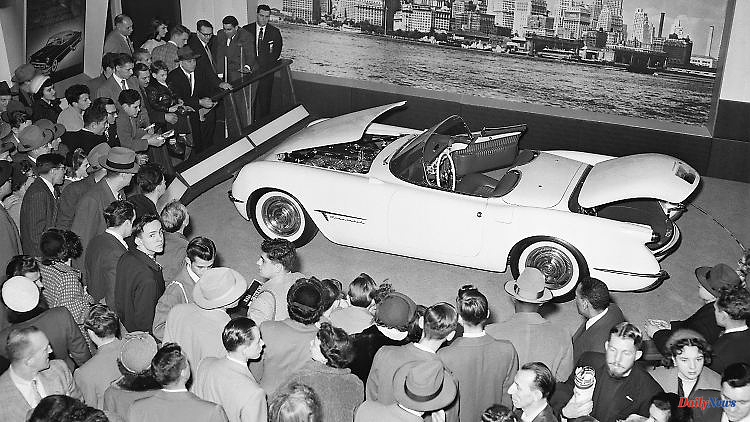Initially, the Corvette was more a cruiser than a racer. But then the sports car, sold in millions, mutated into a poisonous supercar that hunted Jaguars and Porsches with the Stingray emblem. The Corvette is a symbol of the American Dream, adorned by Hollywood, pop stars, politicians and astronauts.
It is this ingenious mix of voluminous V8s in seductive shapes that made the comparatively affordable Chevrolet Corvette the first million-seller among supercars. An American myth in eight generations so far, initially ignited 70 years ago by the first global grand master of car design, Harley J. Earl. And after a bumpy start, the legendary chief engineer Zora Arkus-Duntov brought it into a furious ride.
This former racer demonstrated to General Motors executives in 1956 what America's first plastic-molded sports car needed to beat European icons like the Jaguar XK, but also fast Fords: a sharp V8 for speed records. As the Sting Ray, the Corvette (C2) finally mutated into a poisonous cult racer in 1962, against which Porsche in North America had no chance. In other markets, and especially in Germany, the Corvette found it difficult to assert itself, even in the iconic Coke Bottle contours (Corvette C3). The incarnation of the US sports car was considered thirsty and chubby than Porsche in this country.
That's almost all in the past today, the current Corvette (C8) is relatively efficient and circles around many of its competitors with a mid-engine, and for its 70th birthday, a hybridized Corvette points the way to the future. Only one thing remains the same: "The First All-American Sports Car", as Chevrolet advertised in 1953, is a glamorous all-time favorite for celebrities - and even for Joe Biden, incumbent President of the USA.
The Corvette and the stars, that's what American social history is all about. By the way, President Joe Biden has lived out his fondness for the Corvette for a long time. Not only does the Democrat own a green Corvette Sting Ray (C2), he insisted on being present at milestones in Corvette history even as Vice President. Like when General Motors CEO Mary Barra introduced the 2015 model year Corvette Z06, a performer that propelled total Corvette sales towards a record-breaking two million mark.
The Corvette was designed by Prince ("Little Red Corvette") or Jean
Supersonic jet pioneer Chuck Yeager also piloted a Corvette, as did Alan Shepard, who became the first American to fly into space in 1961 and then climbed into an open Corvette C1. The Apollo 12 astronauts Bean, Conrad and Gordon switched to a Corvette Stingray 427 (C3) with a 7.0-liter big-block V8 in 1969 after a successful moon mission. Meanwhile, prominent women such as Marylin Monroe, artist Shirley Bassey and model Kendall Jenner affirm that, contrary to many prejudices, the Corvette does not only fascinate men.
Nevertheless, male sports car fans and their fondness for British roadsters gave the impetus for the development of the Corvette in 1950. Why do Hollywood stars like Clark Gable and Tyrone Power drive English Jaguars and not a glittering US product in the style of a dream car? Harley J. Earl, the automotive designer and GM manager who has influenced global car body fashion since 1927 with design studies, pontoon shapes and tail fins, asked himself. Harley Earl therefore put a Jaguar XK 120 into the GM studio as a source of inspiration and had a gleaming white, open two-seater built in 1953. The project ran under the code name "Opel" - 15 years later the Corvette should in turn initiate the development of the Opel GT.
When the near-series prototype celebrated its world premiere on January 17, 1953 at the General Motors Motorama Show in New York, the hitherto sportiest Chevrolet was immediately enthusiastically celebrated by the public. Finally, America had its own sports car, with the world first of an excitingly shaped fiberglass body for the mass production.
However, the plastic body of all things was to cause nightmarish problems, because the production that started in the summer showed how complex and expensive the processing of the glass fiber reinforced synthetic resin was. There was also a tired 112 kW/152 hp Chevy six-cylinder. The Corvette (C1) could not score with this - especially since arch-rival Ford did not rest before the two-seater Thunderbird with 156 kW/212 hp V8 dominated the US sports car sales ranking from 1955.
Just under 700 Corvette left the production line that year, but rescue was at hand: engineer Zora Arkus-Duntov, a former racing driver, showed what the Corvette was missing. With a V8 engine releasing 145 kW/197 hp, Duntov accelerated the Corvette to a top speed of 150 miles (241 km/h) in Daytona, the basis for a successful restart of the CFRP runabout. Already in 1958 the sales figures rose to 9000 units. At the same time, Chevrolet gave the Corvette more chrome and futuristic prototypes that pointed to the 1963 Sting Ray (C2).
For many fans, this Sting Ray is the ultimate Corvette, especially as a coupe with a split rear window. The performance values of the Sting Ray, which sold more than 21,000 units in the first year, were almost spectacular. Officially, the up to 7.0-liter V8 released a maximum of 331 kW/450 hp, but unofficially up to 441 kW/600 hp should have been possible. And at 276 km/h, the second Corvette generation set a speed record at Le Mans in 1967. In general, Le Mans, the Indy 500 and other motorsport events: the Corvette still shows the flag here today, not infrequently on the podium.
In 1967, the year of flower power and hippies, the Corvette (C3) was in the starting blocks, for the first time in the contemporary "Coke Bottle" design, which was based on the GM Mako Shark II study. This was still eleven years old third Corvette good for surprises: in 1979, for the first time, more than 50,000 registrations were achieved as an annual result.
The fourth Corvette also remained relevant for an exceptionally long period of time. It was made around 360,000 times in twelve years.
The Corvette celebrated its 50th birthday with a fifth-generation special model. Internally called the C5, this 1997-2004 Corvette impressed more with its exceptional driving performance than with its horsepower. The fastest Corvettes scratched the 300 km/h mark for the first time and the sprint to 100 km/h took 4.7 seconds. The Corvette C6 (2004 to 2013) and C7 (2013 to 2019) mastered these disciplines even better.
There was an outcry among many hard-core Vette fans in 2019: Chevrolet presented the current Corvette (C8) with a mid-engine and without the iconic, gigantic bonnet. The fire has now died down and this American speed symbol can be found next to Ferrari and Porsche on racetracks, in front of grand hotels and in collectors' garages - in the future also as an E-Ray with hybrid drive.
Modellchronik Chevrolet Corvette
1950: In this year the initial spark for the development of the Corvette takes place. The British Jaguar XK 120 established itself as the epitome of the fast sports car on both sides of the Atlantic and it inspired GM Vice President Harley Earl to design an American sports car
1952: Harley Earl presents his designs for a sporty two-seater codenamed "Opel". Development of a concept car that is shown at the GM Auto Show Motorama the following year. The sports car is christened "Corvette" at the suggestion of Chevrolet Public Relations photographer Myron E. Scott. The management justifies the decision with the fact that the name starts with C, sounds good spoken and it is reminiscent of the legendary fast warship type from the Second World War of the same name
1953: On January 17, a near-production Corvette (C1) prototype is unveiled at Motorama in New York's Waldorf-Astoria Hotel. Chevrolet begins production of the Corvette at its Flint, Michigan (USA) plant. Of the 314 Corvette made, only 183 are sold. During its production period, the Corvette (C1) is equipped with a wide range of engines, ranging from the 3.8-liter six-cylinder with 112 kW/152 hp to the 5.3-liter V8 with 265 kW/360 hp or up to the 5.4 liter V8 with 186 kW/253 hp
1955: Zora Arkus-Duntov becomes the chief engineer responsible for the Corvette. 700 Corvettes will be built this year
1958: Bill Mitchell becomes GM's design chief and vice president. In his spare time, he works with GM designers to construct the open-top Sting Ray racing car, which becomes the stylistic model for the next Corvette (C2).
1959: Start of development for the Corvette (C2)
1960: The Corvette Concept Sting Ray wins the SCAA Sportscar Championship
1961: The astronaut Alan Shephard is the first American to fly into space and receives a Corvette after his happy return. In June, the XP-755 Mako Shark concept car, a precursor to the Corvette Sting Ray, makes its debut at Elkhart Lake
1962: The Mako Shark study premieres at the Coliseum in New York. The Corvette Sting Ray will be presented in the summer. Sales figures climb to 21,513 units. The Corvette Sting Ray will be delivered with engines ranging from the 5.3-liter V8 with 276 kW/375 hp to the 7.0-liter V8 with 331 kW/450 hp during its production period
1963: The Corvette model year 1964 makes its debut in the summer. The options list now includes air conditioning and a car radio with station search. The Corvette Grand Sport special series for motorsport enthusiasts is new
1964: Class victory for the Corvette Sting Ray in the GT class at the 12 Hours of Sebring. This success is repeated in 1966, 1967 and 1968
1965: The Corvette Sting Ray becomes available with four-wheel disc brakes. Also new is an optional engine version with petrol injection, which due to a lack of demand was already removed from the delivery program in the following year. For the 1966 model year, the Corvette can also be ordered with a 7.0-liter big-block V8
1966: Headrests are available at extra cost
1967: A Corvette Sting Ray sets a new speed record at Le Mans with 276.00 km/h. Production of the Corvette C2 ends in July. This is followed by the market launch of the third Corvette generation (C3). The chassis is based on the Corvette C2, but the body has a hip swing in the contemporary "Coke Bottle" design. The Corvette (C3) will be equipped with engines ranging from the 5.4-liter V8 with 224 kW/304 hp to the 7.4-liter V8 with 313 kW/425 hp over the course of its production period
1969: The 250,000. Corvette rolls off the assembly line with annual sales of 38,762 units. In November, Apollo 12 starts the second manned flight to the moon, the astronauts receive a Corvette Stingray 427
1970: Sales plummet to just 17,316 units
1972: That year and the following year, another Corvette wins the GT class at the Sebring 12 Hour. At Le Mans, a Corvette breaks another speed record, this time at 339.57 km/h
1973: Despite the oil crisis, 30,464 Corvettes are sold that year. The Corvette 4-rotor concept car (code XP-882) debuts with a four-rotor Wankel engine, but a two-rotor Wankel Corvette (code XP-897 GT) also debuts as a 2-rotor Corvette
1974: The first Corvette Corral Show takes place in Bloomington, Illinois, USA. The show later became legendary as Bloomington Gold
1975: Total production exceeds half a million Corvette. At the same time, a Corvette becomes SCCA Trans Am winner. This sporting success was repeated in 1978, 1979 and 1981
1978: The Corvette Indianapolis 500 pace car competes in the 62nd Indianapolis 500 race
1979: For the first time, more than 50,000 Corvette (53,807 units) are sold in one year, an all-time high
1980: At Bonneville Speed Week, a 1968 twin-turbo Corvette wins the AA/GT class title. With a top speed of 387.413 km/h, it is also the fastest Original Form vehicle in the world
1981: Corvette production moves to Bowling Green, Kentucky, USA
1982: Another slump in Corvette sales to 25,407 units
1983: In March, the fourth Corvette model generation (C4) is presented. During the construction period, the range of engines for the Corvette (C4) essentially comprised engines from the 5.7-litre V8 with 150 kW/205 hp to the 5.7-litre V8 with 298 kW/405 hp
1985: "The Corvette Song" by George Jones celebrates the Corvette, a year later Prince releases the track "Little Red Corvette"
1986: A Corvette convertible is offered for the first time since 1976. The Corvette Convertible Pace Car competes in the 70th Indianapolis 500 race
1988: The Corvette celebrates its 35th birthday with a special model. The Callaway Sledgehammer Corvette reaches a top speed of 410 km/h
1989: The Italian star designer Nuccio Bertone presents the Corvette Nivola concept car with a mid-engine, after showing the Ramarro on a Corvette basis but with a front engine in 1984
1990: At the Firestone Test Center near Fort Stockton, Texas, USA, two ZR-1 and L98 Corvette sets numerous speed records, including a 5000-mile record and a 24-hour distance record
1992: The millionth Corvette, a white LT1 convertible with a red interior, rolls off the production line. The Corvette American Hall of Fame opens in Cooperstown, New York, USA
1993: In motorsport, the Corvette can claim almost a dozen SCAA victories
1994: The first Corvette C5 Alpha is built for testing purposes. The new National Corvette Museum opens in Bowling Green, Kentucky, USA.
1995: At the 24 Hours of Le Mans, Corvettes take second and third place in the GT2 class
1996: Production of the Corvette (C4) ends in the middle of the year, the pre-series of the next Corvette (C5) starts in the fall
1997: The fifth generation Corvette is presented to the public at the Detroit Motor Show and introduced in the same year. Sales figures this year are only 9,752 units. The most important engines in the Corvette (C5) are 5.7-liter V8s with 253 kW/344 hp to 283 kW/385 hp
1998: The C5 convertible rolls into dealerships and Corvette sales soar to 31,084 units
1999: A hardtop variant of the C5 is added to the model range, making three body versions of the Corvette available for the first time
2001: Chevrolet returns to Le Mans with the Corvette
2002: The Corvette celebrates its 50th birthday with the special model "50th Anniversary"
2003: The C5-R Corvette wins several class victories in the American Le Mans Series, such as the Sebring 12 Hours
2005: The sixth generation of the Corvette (C6) celebrates its market launch, this as a coupe and convertible, for the first time since the C1 without pop-up headlights, but with a new V8 engine. Compared to its predecessor, this LS2 engine has a displacement of 5.7 liters to 6.0 liters and has an output of 321 kW/437 hp
2006: A C5-R competes again in the 24 Hours of Le Mans with a private racing team. She finished third, joining second-placed Aston Martin DBR9 and first-placed C6-R. The C6-R engine, the LS7-R, is named Global Motorsport Engine of the Year. The title was handed over to General Motors during the Professional Motorsport World Expo in Cologne
2009: For the 2009 model year, a new Corvette ZR1 (C6) debuts with a supercharged 6.2-liter V8 and 469 kW/638 hp or 476 kW/647 hp for top speeds of 330 km/h
2011: Chevrolet celebrates 50 years since the Corvette first competed at Le Mans with the Corvette Z06 Carbon Limited Edition
2013: The Corvette (C7) is introduced on January 13 in the run-up to the Detroit Auto Show and after a break of more than 30 years it bears the nickname "Stingray". The drive layout consists of a conventional front petrol engine and rear-wheel drive in a transaxle design. The LT1 engine with a displacement of 6.2 liters is direct injection with cylinder deactivation and variable valve timing. The key performance figures include 630 Nm of torque and 343 kW/466 hp. The European market launch will take place at the end of the year
2014: Debut of the Corvette Z06 (C7) with a removable roof section, alternatively there is a classic convertible. The new LT4 V8 aluminum engine with dry sump lubrication has a displacement of 6.2 liters and delivers 478 kW/650 hp or 881 Nm thanks to supercharging
2017: Chevrolet presents the Corvette ZR1 (C7) as a coupe at the Dubai International Motor Show and as a convertible at the Los Angeles Auto Show. An LT5 V8 engine with 563 kW/765 hp and 969 Nm torque provides propulsion. The Corvette ZR1, which can also be recognized by its carbon components and large rear wing, is not officially sold in Europe
2018: The last Corvette C7s are delivered to Europe because they no longer meet upcoming emission standards
2019: In its last year of production, the Corvette (C7) in the USA is offered with the ZR1 package and 555 kW/755 hp, enabling the sprint from 0-60 mph (96 km/h) in under three seconds. The Corvette Stingray (C8) made its debut in Tustin/California in July and was the first Corvette to be based on a mid-engine layout. Conservative Corvette fans criticize the omission of the Corvette-typical long bonnet. The naturally aspirated V8 (LT2) delivers 369 kW/495 hp and 637 Nm of torque with a displacement of 6.2 liters. An eight-speed dual-clutch transmission is new
2020: With the Z51 Performance Package, the Corvette Stingray (C8), which is going into production with a delay, is the first Corvette officially sold in Europe to sprint to 100 km/h in under three seconds. In Australia, the traditional Australian brand Holden offered the Corvette as the Holden Corvette last year
2021: Start of delivery of the current Corvette generation (C8) in Europe
2022: The new version of the Corvette Z06 offers 500 kW/680 hp of power from a 5.5-liter V8 for the US market. GM President Mark Reuss announces an electrified Corvette for 2023
2023: The Corvette turns 70 and the community celebrates the American icon. In Germany, the Corvette Stingray is currently the only available model in General Motors' official model range alongside the Cadillac XT4. The Corvette Stingray in Europe is powered by a 354 kW/482 hp 6.2-liter V8. Chevrolet is launching a 70th Anniversary Edition Corvette and the hybridized Corvette E-Ray is leading the way into an electric future












